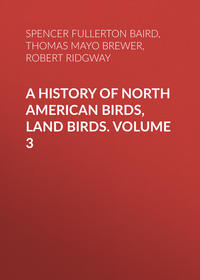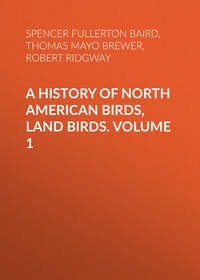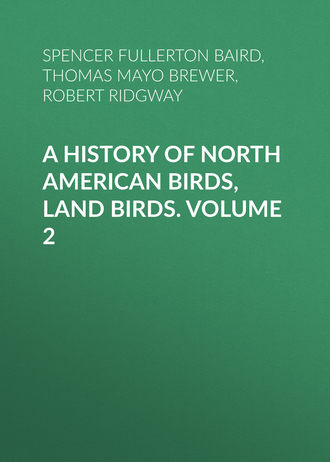 полная версия
полная версияA History of North American Birds, Land Birds. Volume 2
The eggs bear some resemblance to those of the Pyrangæ, but are usually much larger, though they vary greatly in size. Their ground-color is usually a light but well-marked shade of verdigris-green, varying occasionally to a greenish-white, and are marked, more or less, over their entire surface, with blotches of reddish-brown. They vary in length from 1.05 to .90 of an inch, and from .78 to .60.
During incubation, and in the presence of its mate, this Grosbeak is a persistent and enthusiastic singer, and, at times, carries his love of song so far as to betray his nest. This is more especially so when he relieves his mate, takes her place on the nest, and then, apparently oblivious of the danger of lifting up his voice in song when upon so responsible a duty, attracts, by his melody, the oölogist to his treasures.
Dr. Hoy, of Racine, supplies some interesting information in regard to the habits and nesting of this species. On the 15th of June, within six miles of that city, he found seven nests, all within a space of not over five acres, and he was assured that each year they resort to the same locality and nest thus socially. Six of these nests were in thorn-trees, all were within six to ten feet from the ground, and all were in the central portion of the top. Three of the four parent birds sitting on the nests were males, and this he was told was usually the case. When a nest was disturbed, all the neighboring Grosbeaks gathered around and appeared equally interested. Both nest and eggs so closely resemble those of the Tanagers that it is difficult to distinguish them. Their position is, however, usually different, the Grosbeaks generally nesting in the central portion of a small tree, the Tanagers’ being placed on a horizontal limb.
Hedymeles melanocephalus, SwainsonBLACK-HEADED GROSBEAKGuiraca melanocephala, Sw. Syn. Mex. Birds Philos. Mag. I, 1827, 438.—Bon. List, 1838.—Ib. Consp. 1850, 502.—Baird, Birds N. Am. 1858, 498.—Cooper & Suckley, 206. Coccothraustes melanocephala, Rich. List, Pr. Br. Ass. for 1836, 1837. Fringilla melanocephala, Aud. Orn. Biog. IV, 1838, 519, pl. ccclxxiii. Coccoborus melanocephalus, Aud. Synopsis, 1839, 133.—Ib. Birds Am. III, 1841, 214, pl. 206.—Heerm. X, S, 51 (nest).—Cooper, Orn. Cal. I, 228. Goniaphea melanocephala, Sclater? Hedymeles melanocephala, Cabanis, Mus. Hein. 1851, 153. Fringilla xanthomaschalis, Wagler, Isis, 1831, 525. Pitylus guttatus, Lesson, Rev. Zoöl. II, 1839, 102. ? Guiraca tricolor, Lesson, Rev. Zoöl. II, 1839, 102.
Sp. Char. Male. Head above and on the sides, with chin, back, wings, and tail, black. A well-marked collar on the hind neck all round (and in var. capitalis a more or less distinct median stripe on crown, and one behind the eye), edges of interscapular feathers, rump, and under parts generally pale brownish-orange, almost light cinnamon. Middle of belly, axillaries, and under wing-coverts, yellow. Belly just anterior to the anus, under tail-coverts, a large blotch at the end of the inner webs of first and second tail-feathers, a band across the middle and greater wing-coverts, some spots on the ends of the tertiaries, the basal portions of all the quills, and the outer three primaries near the tips, white. Length nearly 8 inches; wing, 4.25; tail, 3.50.
Female has the chin, sides of throat, and superciliary stripe white; the black markings replaced by olivaceous-brown; the cinnamon markings paler, and almost white; the white of wings more restricted; that of tail wanting. Usually there are few or no streaks beneath as in ludovicianus (faint ones on flanks); in young males, however, they are more appreciable. The lemon or gamboge yellow axillars and under coverts in all ages and stages separate this species from H. ludovicianus, the female and young of which have those regions of a saffron or fulvous yellow.
Hab. High Central Plains from Yellowstone to the Pacific. Table-lands of Mexico. Xalapa (Scl. 1859, 365); Orizaba (Scl. 1857, 213); Vera Cruz, Alpine and plateau, breeding (Sum. M. B. S. I, 551).
This bird, in its range of habitat, appears to be represented by two varieties, which, however, run into each other, so that it is often difficult to determine to which variety specimens from intermediate regions should be referred.
Taking the series from Eastern Mexico (Orizaba and Mirador) and northward along the Rocky Mountains of the United States, we find the black of the head continuous, sharply defined by a gently curved outline behind, and without a trace of either the vertex or post-ocular stripes. This is the true melanocephalus, as restricted, and may be regarded as the Rocky Mountain form. The most western specimen is 11,241, from Fort Bridger; the most northern (19,355), from Stinking River, Northern Wyoming. All specimens from the Pacific coast eastward to the western base of the Rocky Mountains, including Cape St. Lucas and Western Mexico south to Colima, differ from the Rocky Mountain series in having the posterior outline of the black hood ragged, and irregularly indented by the rufous of the nape, which always extends in a quite broad stripe toward the eye, along the side of the occiput, and quite frequently forms a conspicuous median vertex stripe, though the latter feature is sometimes not distinct. These differences are observable only in the males, and, although apparently slight, are yet sufficiently constant to justify distinguishing them as races. The Rocky Mountain form being the true melanocephalus, the name capitalis is proposed for the western one.
Habits. This bird occurs from the high Central Plains to the Pacific, and from the northern portions of Washington Territory to the table-lands of Mexico. Mr. Ridgway found this species abundant, during the summer months, in all the fertile wooded districts along the entire route of the survey. At Sacramento it was common in the willow copses, and was observed in the greatest numbers, in May, in the rich valley of the Truckee, in company with Bullock’s Oriole, the Louisiana Tanager, and other species, feeding upon the buds of the “grease-wood.” It principally inhabits the willows along the rivers, and the shrubbery skirting the streams of the mountain cañons. In its manners and notes Mr. Ridgway regards this bird as an exact counterpart of the eastern species, the Hedymeles ludovicianus, its song being by no means superior. The peculiar and very odd click of the ludovicianus is said to be equally characteristic of this bird. Mr. Ridgway met with its nests in willows, about ten feet from the ground. He had evidence that the male bird assists the female in the duties of incubation.
This bird, though a common summer resident in the Great Salt Lake Valley, had all migrated, according to Mr. Allen, by the 1st of September. It is well known there as the Peabird, from its fondness for green peas, of which it is very destructive.
According to Dr. Cooper, this Grosbeak arrives in California, near San Diego, about April 12. It is numerous during the summer throughout the mountains both of the coast and of the Sierra Nevada, and extends its migrations at least as far as Puget Sound. It is often kept in confinement on account of its loud, sweet song. In the Coast Mountains, in May, its music is said to be delightful, the males vying with each other from the tops of the trees, and making the hills fairly ring with their melody.
Dr. Cooper found a nest of this bird, May 12, at the eastern base of the Coast Range. It was built in a low horizontal branch of an alder, and consisted of a few sticks and weeds, very loosely put together, with a lining of grass and roots. The eggs, three in number, he describes as of a pale bluish-white ground, thickly spotted with brown, more densely near the larger end. Their size he gives as .95 by .70 of an inch.
Dr. Cooper also states that they frequent the ground in search of food, but also live much on trees, feeding on their buds. They are not gregarious, assembling only in family groups in the fall. They do not fly high, nor do they make any noise in flying.
He has observed these birds at Santa Cruz April 12, or as early as he saw them at San Diego, three hundred and fifty miles farther south, and has found a young bird fledged as early as May 23.
Dr. Coues speaks of this bird as an abundant summer resident of Arizona, where it arrives by the first of May, and remains until the latter part of September. He speaks of it as frequenting the thick brush of the ravines and the cottonwood and willow copses of the river-bottoms. Its call-note resembles that of Lophortyx gambeli. Its song, he says, is superb,—a powerful, but melodious succession of clear, rich, rolling notes, reminding one somewhat of the Icterus baltimore.
Dr. Suckley speaks of this bird being sparingly found in the vicinity of Fort Steilacoom, Puget Sound, where he obtained two specimens.
Dr. Heermann speaks of the song of this bird as clear and musical, and as very closely resembling that of our Turdus migratorius. He describes its nests as formed with very little care, of twigs loosely thrown together, and lined with roots, placed in the branches of bushes. The eggs, four in number, he describes as of a greenish-blue ground, marked with irregular spots of umber-brown, varying in intensity of shade.
The song of the western species is described by Mr. Nuttall as fully equal, if not superior, to that of the Rose-breasted. He met with it on the central table-lands of the Rocky Mountains, along the upper branches of the Colorado River, where he found it frequenting the thick groves of the streams, and where, throughout its dense forests, the powerful song and the inimitable voice of this “most delightful Finch” cheered that naturalist amidst the wildest desolation of that “forest primeval,” where this superb vocalist made the woods echo and re-echo to its untiring song. These notes, greatly resembling those of its eastern relative, may be heard from early dawn almost even to the close of the following night. These are described as loud, varied, high-toned, and melodious, rising and falling with the sweetest cadence, fascinating the listener most powerfully with sensations of a pleasing sadness, its closing note seeming like a shrill cry of appealing distress, and then sinking faintly on the ear. It is described as very shy and retiring in its habits, and can be but very rarely observed closely while thus engaged in song. On these occasions the bird is said to sit up conspicuously on a lofty bough, near the summit of the tree, his throat swelling with the excitement, and seeming to take a great delight in the sound of his own music.
Mr. Sumichrast found this bird on the Plateau of Mexico, and also in the alpine regions of Vera Cruz. It was found to the height of 8,300 feet, and never lower than 4,000.
The eggs of this species are of an oblong-oval shape, one end but slightly more rounded than the other, and measure 1.10 of an inch in length by .65 in breadth. They have a bluish-green ground, blotched and splashed with markings of a rusty-brown, for the most part more numerous about the larger end.
Genus GUIRACA, SwainsonGuiraca, Swainson, Zoöl. Jour. III, Nov. 1827, 350. (Type, Loxia cærulea, L.)
Coccoborus, Swainson, Class. Birds, II, 1837, 277. (Same type.)
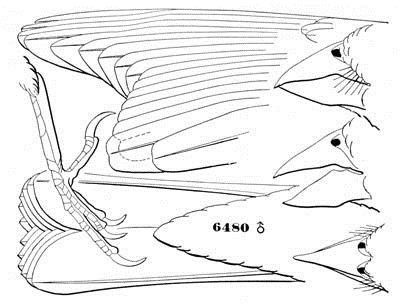
Guiraca cærulea.
6480 ♂
Gen. Char. Bill very large, nearly as high as long; the culmen slightly curved, with a rather sharp ridge; the commissure conspicuously angulated just below the nostril, the posterior leg of the angle nearly as long as the anterior, both nearly straight. Lower jaw deeper than the upper, and extending much behind the forehead; the width greater than the length of the gonys, considerably wider than the upper jaw. A prominent knob in the roof of the mouth. Tarsi shorter than the middle toe; the outer toe a little longer, reaching not quite to the base of the middle claw; hind toe rather longer than to this base. Wings long, reaching the middle of the tail; the secondaries and tertials nearly equal; the second quill longest; the first less than the fourth. Tail very nearly even, shorter than the wings.
The single North American species of this genus has no near relative in tropical America; indeed, no other species at present known can be said to be strictly congeneric.
In all essential details of external structure, and in every respect as to habits and nidification, the type of the genus (G. cærulea) is much more like the species of Cyanospiza than those of Hedymeles, with which latter it has usually been included.
Guiraca cærulea, SwainsonBLUE GROSBEAKLoxia cærulea, Linn. Syst. Nat. I, 1766, 306.—Wilson, Am. Orn. III, 1811, 78, pl. xxiv, f. 6.—? Wagler, Isis, 1831, 525. Guiraca cærulea, Swainson, Birds Mex. in Phil. Mag. I, 1827, 438.—Baird, Birds N. Am. 1858, 499.—Cooper, Orn. Cal. 1, 230. Fringilla cærulea, Aud. Orn. Biog. II, 1834, 140; V, 508, pl. cxxii. Coccoborus cæruleus, Sw. Birds II, 1837, 277.—Aud. Syn. 1839.—Ib. Birds Am. III, 1841, 204, pl. cciv.—Cabanis, Mus. Hein. 1851, 152.—Finsch, Abh. Nat. Brem. 1870, 339 (Mazatlan). Cyanoloxia cærulea, Bp. Conspectus, 1850, 502. Goniaphæa cærulea, Bp. Blue Grosbeak, Pennant, Arc. Zoöl. II, 1785, 351.
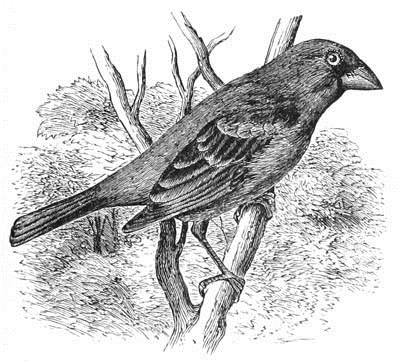
Guiraca cærulea.
Sp. Char. Brilliant blue; darker across the middle of the back. Space around base of the bill and lores, with tail-feathers, black. Two bands on the wing across the tips of the middle and secondary coverts, with outer edges of tertiaries, reddish-brown, or perhaps chestnut. Feathers on the posterior portion of the under surface tipped narrowly with grayish-white. Length, 7.25; wing, 3.50; tail, 2.80.
Female yellowish-brown above, brownish-yellow beneath; darkest across the breast. Wing-coverts and tertials broadly edged with brownish-yellow. Sometimes a faint trace of blue on the tail. The young resembles the female.
Hab. More southern United States from Atlantic to Pacific, south to Costa Rica. Xalapa (Scl. 1859, 365); Oaxaca (Scl. 1859, 378); Cordova (Scl. 1856, 301); Cuba (Cab. J. IV, 9); Vera Paz (Salvin, Ibis, III, 352); Costa Rica (Lawr. IX, 102); Vera Cruz, winter (Sum. M. B. S. I, 552); Yucatan (Lawr. IX, 200).
The species described as Cyanospiza parellina in the Birds of North America, but which so far has not been actually detected north of Mexico, is a miniature Guiraca, more related, however, to the G. concreta than to cærulea. It is easily distinguished from the latter by more lobed bill, darker back and under parts, absence of rufous wing-bands, and inferior size. Length, 5 inches; wing, 2.50.
Males from the Pacific coast region (California, Colima, etc.) have tails considerably longer than eastern specimens, while those from California are of a much lighter and less purplish blue, the difference being much the same as between Sialia sialis and S. azurea.
Autumnal and winter males have the feathers generally, especially on the back and breast, tipped with light brown, obscuring somewhat the blue, though producing a beautiful appearance.
Habits. The Blue Grosbeak, though more a bird of the Southern States, is also one both of an extended and of an irregular distribution. It was even met with one year in the vicinity of Calais, Me., although none have been known to occur in any part of the country between that point and New York City. It is found from the Atlantic to the Pacific coast.
The extent to which it is distributed throughout California is inferred, rather than known. Dr. Cooper noticed one at Fort Mohave, May 6, and afterwards saw many more frequenting the trees and bushes along the river, and singing a lively song, which he compares with that of the Carpodacus frontalis. He also saw them at Los Angeles and at Santa Barbara, and states that they were found at Pit River, in the extreme northeastern part of the State, by Dr. Newberry. They were observed to frequent the banks of streams crossing the great interior plains and deserts, where there was little vegetation except a few bushes.
The Blue Grosbeak was only met with by Mr. Ridgway and his party at Sacramento. It does not occur—or, if so, it was not seen—in the interior so far to the north as the route of Mr. King’s survey. At Sacramento it was found frequenting the same localities as the Cyanospiza amæna, and appeared to be characteristic of the cottonwood copses. Their nests were found between the 18th and the 29th of June, and were all in similar situations. These were built in small cottonwood-trees, on the edge of the copse, and were all about six feet from the ground.
Mr. John Burroughs, in one of his charming popular essays10 on the general habits of our birds, refers to their occasional preference, in sites for their nests, of the borders of frequented roadsides, and mentions finding a nest of the Blue Grosbeak among the trees that line one of the main streets and fashionable drives leading out of Washington City, less than half a mile from the boundary. There, he states, this bird, which, according to Audubon’s observations, is shy and recluse, affecting remote marshes and the borders of large ponds of stagnant water, had placed its nest in the lowest twig of the lowest branch of a large sycamore immediately over a great thoroughfare, and so near the ground that a person standing in a cart or sitting on a horse could have reached it with his hand. The nest was composed mainly of fragments of newspaper and stalks of grass, and though so low, was remarkably well concealed by one of the peculiar clusters of twigs and leaves which characterize this tree. The nest contained young when he discovered it, and though the parent birds were much annoyed by his loitering about beneath the tree, they paid but little attention to the stream of vehicles that was constantly passing. It was a source of wonder to him when the birds could have built it, as they are so much shyer when building than at other times. They must have worked mostly in the early morning, when they could have the place all to themselves. The same observer also noticed another pair of Blue Grosbeaks that had built their nest in a graveyard within the city limits. This was placed in a low bush, and the male continued to sing at intervals till the young were ready to fly. The song of this bird he describes as a rapid, intricate warble, like that of the Indigo Bird, though stronger and louder. Indeed, these two birds so much resemble each other in color, form, voice, manner, and general habits, that, were it not for the difference in size,—the Grosbeak being nearly as large again as the Indigo Bird,—he thinks it would be a hard matter to tell them apart. The females of both birds are clad in the same reddish-brown suits, as are also the young during the first season.
The nest of this species has also been found built in a tree within the grounds of the Smithsonian Institution, Washington.
The only time I ever met with this species was at Carlisle, Penn., in June, 1843. The previous month Professor Baird had found its nest in a low tree, in open ground, and we found these birds still frequenting the same grounds, where we found another nest containing three eggs. It was in a low thorn-tree on the edge of a wood, but standing out in open ground. The nest was about five feet from the ground.
The Smithsonian specimens are from Carlisle, Penn., obtained in April, May, and August; from Georgia, Texas, New Mexico, Nebraska, Mexico, etc. Mr. Lawrence enumerates this among the birds found near New York City. Mr. Dresser found it common near Matamoras in July and August. It was breeding there, though, owing to the lateness of the season, he was unable to procure any of its eggs. Dr. Coues speaks of it as generally distributed in Arizona, but nowhere very common. A single specimen was taken near Fort Whipple, August 10. Turnbull regarded it as a rare straggler to the southern counties of Pennsylvania and New Jersey, arriving there in the middle of May. Dr. Woodhouse found it common in the Indian Territory and Texas. Lieutenant Couch mentions seeing this bird first near Monterey, the male always preceding the female. He speaks of them as exceedingly tame. Mr. J. H. Clark states that this bird was not often seen, and, when observed, was generally solitary, preferring the dark ravines and the cañons on the mountain-sides. It is not mentioned by Sumichrast as a bird of Vera Cruz, but was found during the winter months at Oaxaca, Mexico, by Mr. Boucard.
Mr. O. Salvin states (Ibis, III, p. 352) that he found this species, though not of very common occurrence, pretty generally distributed, in winter, throughout Vera Paz. He met with it on the Plains of Salamà, and all the collections from the warmer districts to the northward of Coban contained specimens. It was found by Mr. George H. White near Mexico.
Wilson speaks of this bird as retired and solitary, and also as a scarce species, and as having but few notes, its most common one being a loud chuck. He was, however, aware that at times they have a few low sweet-toned notes. He mentions their being kept in Charleston in cages, but as seldom singing in confinement. He fed a caged bird of this species on Indian corn, which it easily broke with its powerful bill; also on hemp-seed, millet, and berries. He speaks of them as timid, watchful, silent, and active.
Mr. Audubon was, apparently, somewhat at fault in regard to the peculiarities of this species. His accounts of the eggs of the Pyranga æstiva are entirely inapplicable to that species, and, so far as I know, apply to no other bird than the Blue Grosbeak, to which they exactly correspond. He makes no mention and gives no description of the eggs of the latter. His statements as to the nest appear to be correct.
Dr. Bachman kept several of these birds in an aviary; two of these mated, took possession of the nest of a Cardinal Grosbeak, which they drove off, and laid two eggs that were unfortunately destroyed. In the aviary these birds were silent. Mr. Audubon kept one, in confinement, with him in Edinburgh. It had been raised from the nest. This bird frequently sang in the night, and before dawn. It was extremely tame, coming out or going into its cage at pleasure, perching on the head-dress of Mrs. Audubon, or on the heads of other members of the family, alighting on the table and feeding on almost anything given to it. If a gold or silver coin was thrown upon the table he would go to it, take it up in his bill, and apparently toss it about with pleasure. After bathing he would go to the fire and perch on the fender to dry himself. He would attack other birds, if put into the cage with him. In feeding he sometimes held his food in his claws like a Hawk.
The eggs of this bird are of a uniform light-blue color, and most resemble those of the Sialia arctica, but are larger and of a lighter color. Their color is quite fugitive, and readily fades into a dull white upon even a slight exposure to light. They are of an oval shape, equally rounded at either end, and measure .98 of an inch in length by .65 in breadth.
Genus CYANOSPIZA, BairdPasserina, Vieillot, Analyse, 1816. Not of Linnæus, used in Botany.
Spiza, Bonaparte, Synopsis, 1828. Not of 1825.
Cyanospiza, Baird. (Type, Tanagra cyanea, L.)
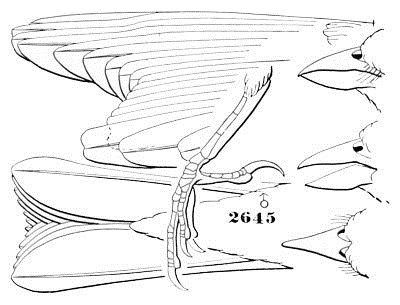
Cyanospiza amœna.
2645 ♂
Gen. Char. Bill deep at the base, compressed; the upper outline considerably curved; the commissure rather concave, with an obtuse, shallow lobe in the middle. Gonys slightly curved. Feet moderate; tarsus about equal to middle toe; the outer lateral toe barely longer than the inner, its claw falling short of the base of the middle; hind toe about equal to the middle without claw. Claws all much curved, acute. Wings long and pointed, reaching nearly to the middle of the tail; the second and third quills longest. Tail appreciably shorter than the wings; rather narrow, very nearly even.


